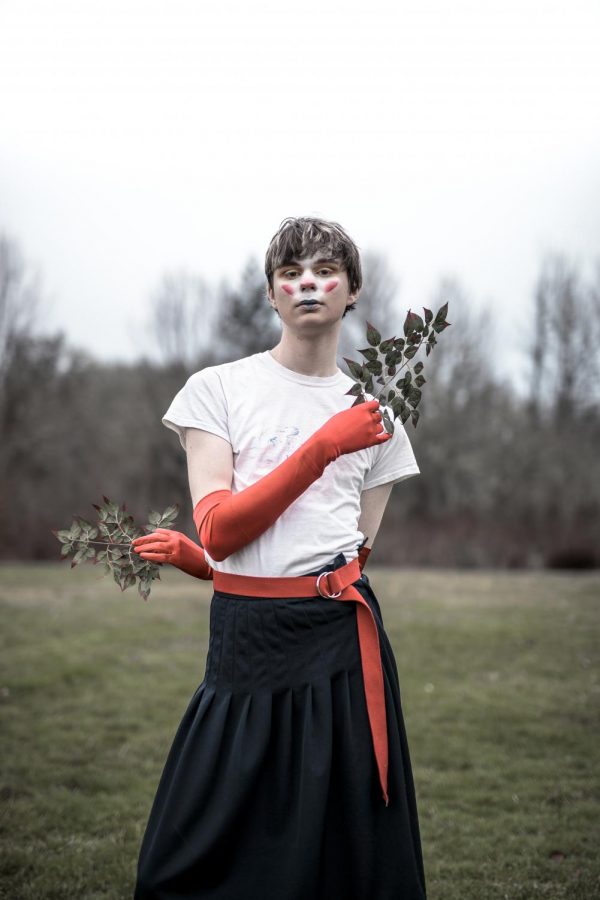Synthetic Camp
April 24, 2021
It is undeniable the shockwaves that went through Twitter and discussions on social media the day Harry Styles graced the cover of a prominent fashion magazine wearing a skirt. As a femme and gender-nonconforming presenting queer man, I had many straight friends come up, expecting applause of the “bravery” exhibited by Styles. Suffice to say, I felt unimpressed and confused by the mainstream attention. If anything, it highlights the issues within queer spaces that heterosexual society generalizes. Within fashion, we’ve seen a rise in extrapolation and abstraction of the idea of Camp, an inherently queer concept highlighting the ostentatious and the boundary-breaking. As the idea of camp rises, the more we see the erasure of queer iconography and history.
We come to a problem here where “camp” is recognized predominantly by the 2019 Met Gala Theme, Camp: Notes on Fashion. The Metropolitan Museum of Art based the exhibit on Susan Sontag’s infamous 1964 essay “Notes on Camp.” The night was filled with celebrities, predominantly heterosexual, who abstracted the idea of camp to “weird,” coming simply in a brightly colored dress or suit. In short, they did not do their homework.
However, we can’t blame them. Camp is a complex concept that is difficult to define. Camp is an accidental celebration of the spontaneous, the humorous, and the breaking of norms. Within her essay, Sontag defines camp through a listicle format, detailing and outlining a multifaceted, queer theory into 58 simple commandments. The rules range from “To camp is a mode of seduction — one which employs flamboyant mannerisms susceptible of a double interpretation” to “Not only is there a Camp vision, a Camp way of looking at things.”
The latter example is a popular application, in which we describe bad movies with cult followings “campy.” Camp filmmaker John Waters describes the eye for camp perfectly in his book “Shock Value: A Tasteful Book About Bad Taste.” Waters writes, “.. bad taste is what entertainment is all about… but one must remember that there is such a thing as good bad taste and bad bad taste. To understand bad taste one must have very good taste.” Camp is very much based on this foundational idea that something can be so bad that is good. In terms of mainstream appeal, think of it like watching a terrible B-horror movie and joking about it with your friends.
The issue with camp’s rise in popularity is the continual erasure of its roots. When Styles is paraded about as breaking barriers for wearing a skirt, it is dismissive of the people whose lives are truly centered and often put in danger for simply being themselves. An example I often bring up is the production of the 1990 documentary Paris is Burning, directed by Jennie Livingston. The film follows the 1980’s house and ballroom scene in New York made up of BIPOC performers, drag legends, and transgender individuals. The balls included categories, such as Executive, Femme Queen, and even Military; it is full camp, it was performative while encapsulating themselves. The film brought the dance “voguing” into the mainstream, a form in which you replicate poses made by models.
While the film is an amazing cultural touchstone for queer history and culture, Livingston (who comes from a white, upper-middle-class background) pocketed the profits. Many of the performers who were featured in the documentary did not see a single penny from the film and died of HIV/AIDS. As for voguing, Madonna adopted it for her hit “Vogue,” leading to the heterosexual connection of voguing as her creation.
When I see Harry Styles in a skirt, I don’t see courage or boundary-breaking. Coming from a fan, I see someone who is benefitting from a place of privilege, sexual ambiguity, and an upper-class status. BIPOC gender-nonconforming individuals have done what he has for centuries and have been incarcerated, systemically oppressed, beaten, sexually assaulted, and killed for expressing themselves. The adoption of camp in a mainstream, heterosexual situation is a cop-out for straight society to say to queer people, “Look, we have a man in a skirt! Aren’t you satisfied?” It’s tiring to see straight people fawned over for things queer people have done for ages.
So where do we go from here? Is camp untouchable? The answer is no, we just need better representation. We need more representation in fashion and the arts that pay to uplift the voices of queer BIPOC folk. We need to teach the history of pop culture and its abstractions. Most importantly, we need to give credit and understand the importance of proper representation.


